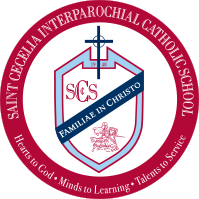Sophia Institute, Spirit of Truth offers Kindergarten, First, and Second graders numerous stories, videos, worksheets, interactive whiteboard lessons and activities to learn about faith and the Catholic religion. The students learn about the special relationship which exists between us and Jesus, our friend and brother. Second graders prepare for the Sacrament of Reconciliation and the Eucharist through local parish programs supported and reinforced at school. The Dynamic Catholic resources for First Reconciliation and First Communion are utilized to enhance the student’s preparation for the Sacraments. Grades K-2 utilize Family Life books which include lessons to be shared with families. Kindergarten students gain real life experience of parish life through a retreat at one of our supporting parishes. All grades participate in a service-learning project.
Primary – Kindergarten, 1st & 2nd Grade
PRIMARY AT ST. CECELIA SCHOOL | K-2 CURRICULUM OVERVIEW
Religion
Language Arts
Guided Reading: Literacy Footprints (Jan Richardson) Guided reading is a research-based approach to teaching reading (Iaquinta, 2006) that is an essential part of a balanced and comprehensive literacy program. This small-group reading instruction is designed to provide differentiated teaching to a broad range of learners in a classroom (Pinnell & Fountas, 2010). The teacher uses a range of assessment tools to determine their students’ strengths and deficits. Students are placed into small groups based on their instructional needs. This allows the teacher to focus precisely on what the students need to learn in order to advance. The teacher selects a text which provides students with a few challenges, as well as enough support to read it with a high degree of accuracy (90% or greater).
Writing
Kindergarten
Kindergarteners are often enthusiastic writers and they will weave writing activities into their play. Invented spelling is normal at this age, as children are translating the sounds of spoken words into writing. Children at this age can read their own writing and should be encouraged to read aloud! They should also be encouraged to
- Print their first and last name in lower case letters, except the beginning letter.
- Draw a picture that tells a story and label or write about the picture.
- Recognize and write both upper- and lowercase letters (may not be clearly written)
- Understand reading and writing goes from left to right
1st Grade
First graders write many times a day to express their ideas and interests — they are writing with a purpose, through, stories, letters, and lists. They can print clearly and leave spaces between words. Children in first grade are able to write simple but complete sentences, and they are beginning to understand when to use capital letters, commas, and periods. In their writing, you’ll see a combination of invented and correct spelling (especially words from a word wall or vocabulary list). First graders also begin to use “story language” in their own writing, for example, incorporating phrases such as “once upon a time” and “happily ever after.”
2nd Grade
Second graders are polishing a wide range of basic writing skills, including writing legibly, using capitalization and punctuation correctly, and moving from invented spelling to more accurate spelling. For most, handwriting becomes automatic, so they can concentrate more on the content of their writing rather than on the mechanics. Second graders work hard to learn how to organize their writing to include a beginning, middle, and end. They can typically write a simple essay with a title and introductory sentence, provide examples and details that support their main concept, and write a concluding sentence.
Mathematics
Sadlier – https://www.sadlier.com/school/sadlier-math-preview
A comprehensive core math program provides a pedagogy which reflects the keystones of mathematical learning that empowers students to:
- Foster conceptual understanding and skill development with a cohesive grouping of lessons, explicit instruction, and guided and independent practice.
- Strengthen metacognitive development and promote learning with abundant real-world problem solving and applications related to STEAM.
- Harness innovative support for teaching and learning with embedded professional development, robust digital tools, and a comprehensive assessment plan.
Science
The elementary science curriculum introduces students to aspects of natural science, including tree, physics, biology, astronomy, meteorology, and geology. Students gain acquaintance with the properties of the elements, they study at grade appropriate levels targeting changes in states of matter, electricity, magnetism, mechanics, and the properties of light and sound. The curriculum includes studies of the stars, solar system, planets, the physical formation and structure of the earth, including the studies of minerals and fossils and geological change. Students gain an understanding of seasons, climate, and weather phenomena.
Social Studies
At each grade level, students are provided opportunities to learn and apply the lessons from the study of history, geography, political science, and economics. Helping students develop a global perspective and an appreciation of cultures, other than their own, is emphasized through the instructional program. Elementary teachers utilize thematic units in addition to the Social Studies Weekly series.
- Kindergarten– My World
- Grade 1– School and Family
- Great 2 – Neighborhoods

About Us
St. Cecelia Interparochial Catholic School (SCS) offers an academically challenging and globally minded interdisciplinary education to children in PreK-3 through 8th grade.
Contact Us
1350 Court Street
Clearwater, FL 33756
Phone: 727-461-1200
Fax: 727-446-9140
Admissions: 727-461-1207
Extended Day: 727-385-4851
(3:30-6:00pm)
Quick Links
© Copyright 2015 Saint Cecelia Interparochial Catholic School. Website designed and developed by BayshoreSolutions.

